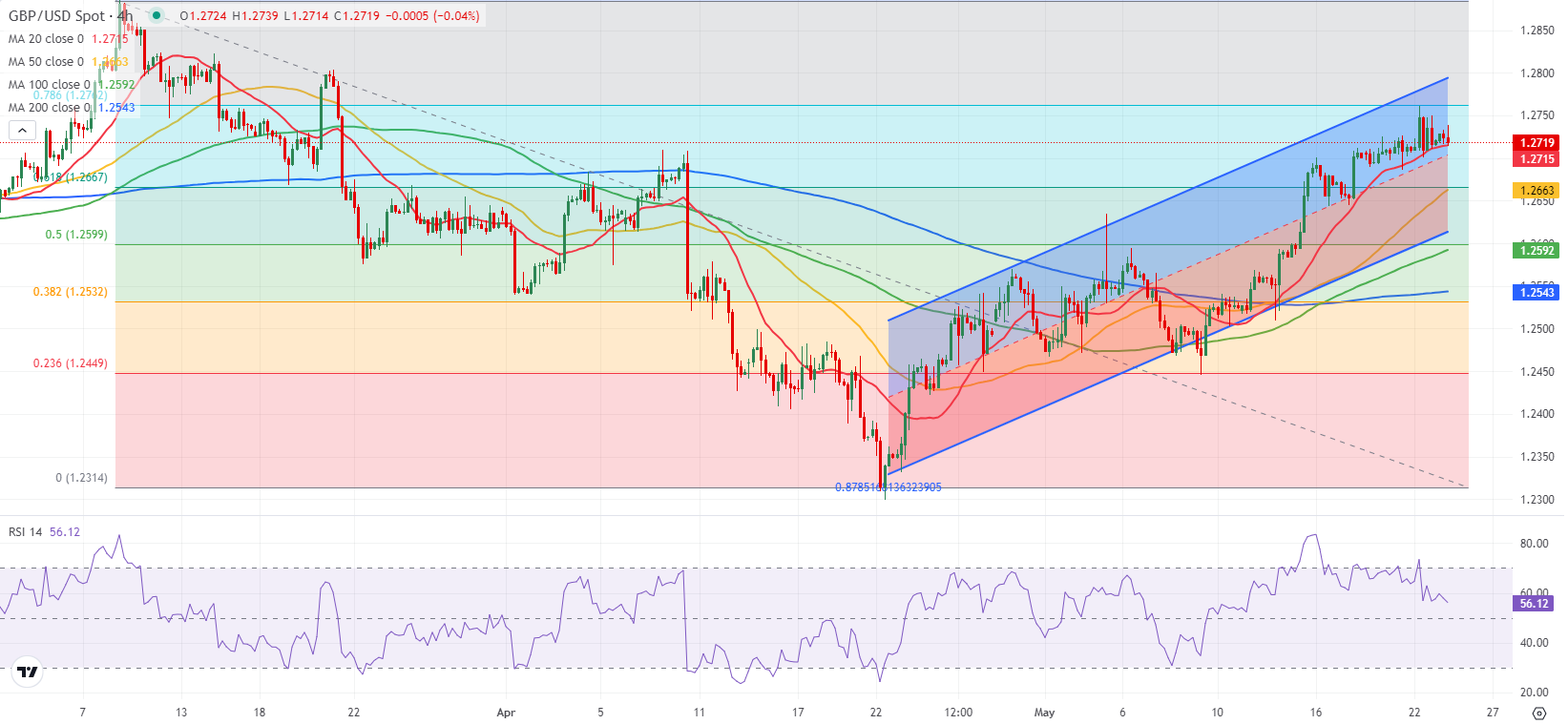- GBP/USD trades above 1.2700 in the European session on Thursday.
- UK PMI data showed that private sector continued to grow in May.
- Markets await PMI reports and Initial Jobless Claims data from the US.
GBP/USD climbed to a two-month-high above 1.2750 on Wednesday after the UK inflation data for April came in stronger than expected but lost its traction in the American session to close the day little changed. Early Thursday, the pair trades in a tight range above 1.2700.
British Pound PRICE This week
The table below shows the percentage change of British Pound (GBP) against listed major currencies this week. British Pound was the strongest against the Australian Dollar.
| USD | EUR | GBP | JPY | CAD | AUD | NZD | CHF | |
|---|---|---|---|---|---|---|---|---|
| USD | 0.29% | -0.11% | 0.72% | 0.43% | 0.98% | 0.31% | 0.59% | |
| EUR | -0.29% | -0.43% | 0.48% | 0.15% | 0.72% | 0.02% | 0.31% | |
| GBP | 0.11% | 0.43% | 0.76% | 0.58% | 1.14% | 0.44% | 0.71% | |
| JPY | -0.72% | -0.48% | -0.76% | -0.30% | 0.26% | -0.40% | -0.13% | |
| CAD | -0.43% | -0.15% | -0.58% | 0.30% | 0.50% | -0.14% | 0.14% | |
| AUD | -0.98% | -0.72% | -1.14% | -0.26% | -0.50% | -0.71% | -0.40% | |
| NZD | -0.31% | -0.02% | -0.44% | 0.40% | 0.14% | 0.71% | 0.28% | |
| CHF | -0.59% | -0.31% | -0.71% | 0.13% | -0.14% | 0.40% | -0.28% |
The heat map shows percentage changes of major currencies against each other. The base currency is picked from the left column, while the quote currency is picked from the top row. For example, if you pick the British Pound from the left column and move along the horizontal line to the US Dollar, the percentage change displayed in the box will represent GBP (base)/USD (quote).
The minutes of the Federal Reserve's (Fed) April 30-May 1 policy meeting showed that some policymakers were willing to reconsider rate increases if necessary. Although the meeting took place before the US inflation data for April showed modest progress in disinflation, the US Dollar (USD) gathered strength against its rivals after the release of the minutes.
Early Thursday, S&P Global/CIPS reported that Composite PMI in the UK edged lower to 52.8 in May's flash estimate from 54.1 in April. This reading came in below the market expectation of 54 and pointed to a loss of growth momentum in the private sector's business activity. In turn, GBP/USD struggled to stage a rebound.
Commenting on the PMI surveys, “the flash PMI survey data for May signalled a further expansion of UK business activity, suggesting the economy continues to recover from the mild recession seen late last year," said Chris Williamson, Chief Business Economist at S&P Global Market Intelligence.
"The survey data are consistent with GDP rising by around 0.3% in the second quarter, with an encouraging revival of manufacturing accompanied by sustained, but slower, service sector growth," Williamson added.
In the second half of the day, S&P Global PMI data for the US will be watched closely by market participants. An unexpected drop below 50 in the Composite PMI could hurt the USD and allow GBP/USD to regain its traction. On the other hand, a reading above 52 could have the opposite effect on the pair's action. The US economic docket will also feature the weekly Initial Jobless Claims data.
GBP/USD Technical Analysis
GBP/USD holds in the upper half of the ascending regression channel but the Relative Strength Index (RSI) indicator on the 4-hour chart declines toward 50, highlighting a loss of bullish momentum.
On the downside, 1.2710-1.2700 (mid-point of the ascending channel, static level) aligns as immediate support before 1.2660 (50 period Simple Moving Average (SMA), Fibonacci 61.8% retracement of the latest downtrend) and 1.2600 (lower limit of the ascending channel).
Resistances are located at 1.2760 (Fibonacci 78.6% retracement), 1.2800 (upper limit of the ascending channel) and 1.2850 (static level).
Pound Sterling FAQs
The Pound Sterling (GBP) is the oldest currency in the world (886 AD) and the official currency of the United Kingdom. It is the fourth most traded unit for foreign exchange (FX) in the world, accounting for 12% of all transactions, averaging $630 billion a day, according to 2022 data. Its key trading pairs are GBP/USD, aka ‘Cable’, which accounts for 11% of FX, GBP/JPY, or the ‘Dragon’ as it is known by traders (3%), and EUR/GBP (2%). The Pound Sterling is issued by the Bank of England (BoE).
The single most important factor influencing the value of the Pound Sterling is monetary policy decided by the Bank of England. The BoE bases its decisions on whether it has achieved its primary goal of “price stability” – a steady inflation rate of around 2%. Its primary tool for achieving this is the adjustment of interest rates. When inflation is too high, the BoE will try to rein it in by raising interest rates, making it more expensive for people and businesses to access credit. This is generally positive for GBP, as higher interest rates make the UK a more attractive place for global investors to park their money. When inflation falls too low it is a sign economic growth is slowing. In this scenario, the BoE will consider lowering interest rates to cheapen credit so businesses will borrow more to invest in growth-generating projects.
Data releases gauge the health of the economy and can impact the value of the Pound Sterling. Indicators such as GDP, Manufacturing and Services PMIs, and employment can all influence the direction of the GBP. A strong economy is good for Sterling. Not only does it attract more foreign investment but it may encourage the BoE to put up interest rates, which will directly strengthen GBP. Otherwise, if economic data is weak, the Pound Sterling is likely to fall.
Another significant data release for the Pound Sterling is the Trade Balance. This indicator measures the difference between what a country earns from its exports and what it spends on imports over a given period. If a country produces highly sought-after exports, its currency will benefit purely from the extra demand created from foreign buyers seeking to purchase these goods. Therefore, a positive net Trade Balance strengthens a currency and vice versa for a negative balance.
Information on these pages contains forward-looking statements that involve risks and uncertainties. Markets and instruments profiled on this page are for informational purposes only and should not in any way come across as a recommendation to buy or sell in these assets. You should do your own thorough research before making any investment decisions. FXStreet does not in any way guarantee that this information is free from mistakes, errors, or material misstatements. It also does not guarantee that this information is of a timely nature. Investing in Open Markets involves a great deal of risk, including the loss of all or a portion of your investment, as well as emotional distress. All risks, losses and costs associated with investing, including total loss of principal, are your responsibility. The views and opinions expressed in this article are those of the authors and do not necessarily reflect the official policy or position of FXStreet nor its advertisers. The author will not be held responsible for information that is found at the end of links posted on this page.
If not otherwise explicitly mentioned in the body of the article, at the time of writing, the author has no position in any stock mentioned in this article and no business relationship with any company mentioned. The author has not received compensation for writing this article, other than from FXStreet.
FXStreet and the author do not provide personalized recommendations. The author makes no representations as to the accuracy, completeness, or suitability of this information. FXStreet and the author will not be liable for any errors, omissions or any losses, injuries or damages arising from this information and its display or use. Errors and omissions excepted.
The author and FXStreet are not registered investment advisors and nothing in this article is intended to be investment advice.
Recommended Content
Editors’ Picks

EUR/USD trades sideways below 1.0450 amid quiet markets
EUR/USD defends gains below 1.0450 in European trading on Monday. Thin trading heading into the Xmas holiday and a modest US Dollar rebound leaves the pair in a familair range. Meanwhile, ECB President Lagarde's comments fail to impress the Euro.

GBP/USD stays defensive below 1.2600 after UK Q3 GDP revision
GBP/USD trades on the defensive below 1.2600 in the European session on Monday. The pair holds lower ground following the downward revision to the third-quarter UK GDP data, which weighs negatively on the Pound Sterling amid a broad US Dollar uptick.

Gold price sticks to modest gains; upside seems limited amid USD dip-buying
Gold price attracts some follow-through buying at the start of a new week and looks to build on its recovery from a one-month low touched last Thursday. Geopolitical risks stemming from the protracted Russia-Ukraine war and tensions in the Middle East, along with trade war fears, turn out to be key factors benefiting the safe-haven precious metal.

The US Dollar ends the year on a strong note
The US Dollar ends the year on a strong note, hitting two-year highs at 108.45. The Fed expects a 50-point rate cut for the full year 2025 versus 4 cuts one quarter earlier, citing higher inflation forecasts and a stubbornly strong labour market.

Bank of England stays on hold, but a dovish front is building
Bank of England rates were maintained at 4.75% today, in line with expectations. However, the 6-3 vote split sent a moderately dovish signal to markets, prompting some dovish repricing and a weaker pound. We remain more dovish than market pricing for 2025.

Best Forex Brokers with Low Spreads
VERIFIED Low spreads are crucial for reducing trading costs. Explore top Forex brokers offering competitive spreads and high leverage. Compare options for EUR/USD, GBP/USD, USD/JPY, and Gold.
